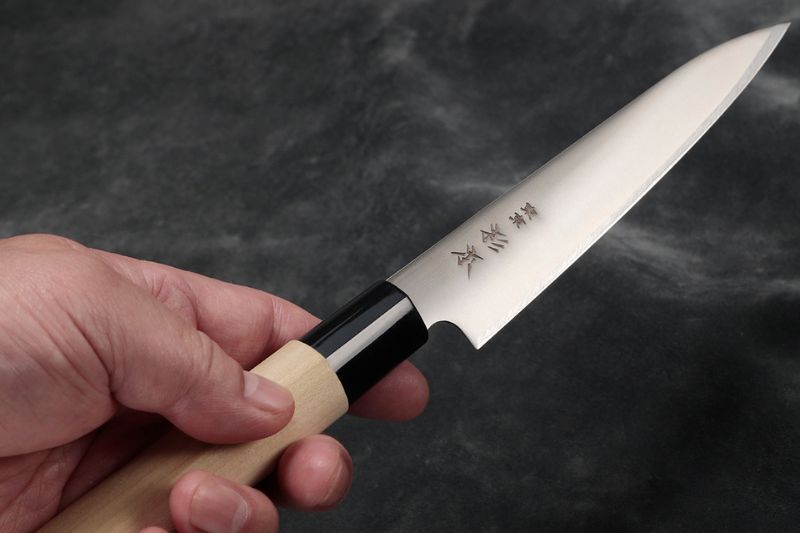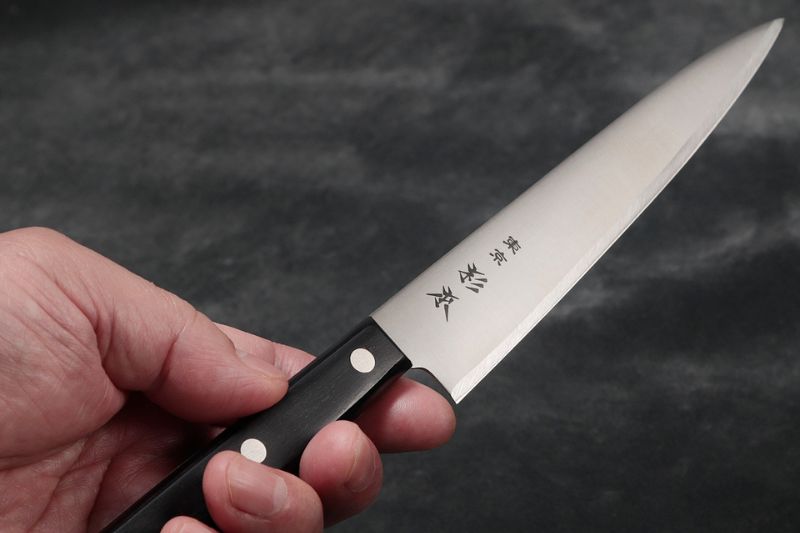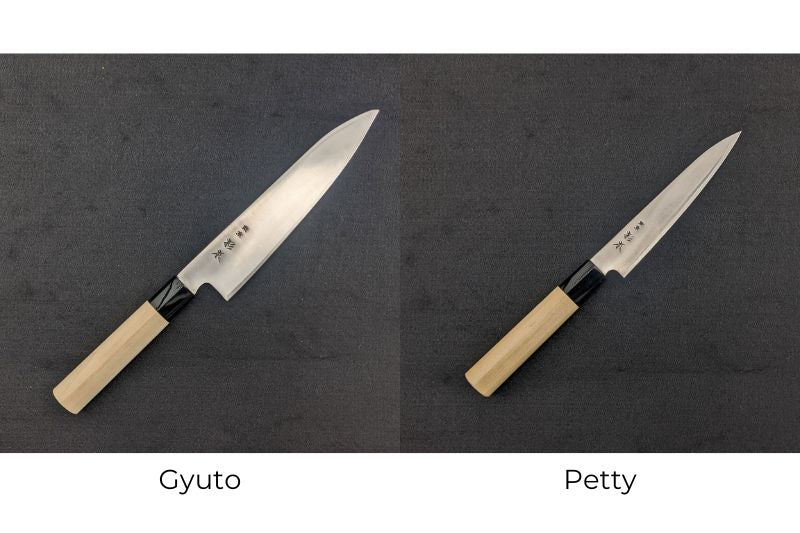The Petty Knife
Every once in a while in the kitchen, there's a job that a primary knife like a Gyuto or Bunka can't handle. For example, try peeling a vegetable with a long knife. Not only is it a difficult task, but it can also be a bit dangerous. That's where the often-overlooked Petty knife comes in handy—proving that bigger isn't always better; the Petty comes to the fore when precision is needed.
An Overperforming Underdog: The Structure of This Article
So, let's dive in and discover what makes the Petty knife indispensable in kitchens today. In this article, I will begin by discussing the link between French and Japanese culture and how this impacted Japanese knife design, leading to the creation of the Petty knife. Then, I'll tell you about the different things you can do with this marvelous knife. If you want to learn more about how Japanese culture and knives rapidly changed, read my previous posts about the Deba and the Gyuto.


The History of the Petty Knife
Like the Gyuto and Bunka, the Petty knife first appeared sometime during the Meiji 明治period (1868 - 1912 CE). The Gyuto was created to be like the Western chef's knife, and the Petty was intended to be both like a Western paring and utility knife. The name "Petty" is thought to come from the French word "petit," meaning "small."
During the Meiji Period, the Japanese Became Intrigued With French Cuisine
Until then, the Japanese had a tradition of mainly eating seafood and vegetables. But everything changed when they began renewed trading and relations with the rest of the world. Because of Western influence, the Japanese started consuming more beef, pork, and poultry. In addition, French cuisine, in particular, captivated the Japanese aristocracy.
Emperor Meiji Frequently Served French-Style Food at Events
For lunch in 1904, the Emperor served his guests dishes such as filet de bœuf à la godard (beef with truffles and mushrooms), côtelettes de cailles à la chantilly (quail with goose liver), and asperges à la béchamel (asparagus with bechamel sauce). And that's just three courses out of nine or ten! This fine-dining French fare became common at official government functions and even the Emperor's birthday parties.
This New Obsession With French Cooking Birthed the Petty Knife
The upper echelon of Japan was impressed with the refined style of French cookery. In some ways, this isn't surprising. Although the French and Japanese cultures differed in many ways, they had a commonality: appreciation for the small details and extreme professionalism.
Inspired, the Japanese wanted to imitate the French. But, the Japanese love to put their own twist on things, which led to the creation of the Gyuto and the Petty knife among others. These knife designs took the best of both cultures and endure to this day.
This Relationship Still Exists Today, With Both Countries Continuing to Inspire Each Other
The Petty knife can now be found in both Japanese and Western kitchens. Japanese and French chefs have inspired each other; the Japanese have taken on French techniques, dishes, and culinary tools. The fresh, flawless simplicity and careful nature of Japanese cooking have significantly impacted French fine-dining. If you go to Japan today, you may be surprised at how easy it is to find delicious Western-style food. Likewise, many of the top chefs in France love to cook Japanese-French fusion cuisine.

Features
Perfect for Big or Small Jobs, the Petty Comes in a Wide Array of Sizes
Usually, a Petty will have a blade anywhere from 120mm to 150mm. That means you can use a larger Petty knife as your primary knife if you want to. This is perfect for people with small hands or a kitchen with limited space. However, if you have larger hands, you may find that your knuckles hit the cutting board when you use it for chopping, so be sure to choose the correct size.
All the Benefits of a Gyuto in a Smaller Package
You may notice that the Petty looks like a miniature Gyuto. It has the same slight curve, allowing for rock-chopping. Similarly, it has the same sharp tip for precision work. Indeed, the Petty practically is a Gyuto, except that it’s lighter and more maneuverable. The shorter blade allows for better control.

How to Use a Petty Knife
Use the Petty on or off the Cutting Board
As I mentioned earlier, you can use the Petty knife for chopping on the board. That's its main advantage over the standard Paring knife. The Petty can do push-cuts, rock-chopping, and fine dicing. On top of that, it's great for herbs and small vegetables like chili or garlic. Consider getting a larger Petty (150mm) if you intend to use it this way.
Also Great When Used for Handwork
Many people get a Petty knife (in smaller sizes) to use off the board in their hand. That means peeling and shaping vegetables with a degree of care that isn't possible on the board. It's helpful if you're trying to make beautiful garnishes or fruit platters. However, when you use it this way, be cautious - don't cut yourself!

Not Just for Vegetables, the Petty Knife Can Help With Meats and Assorted Tasks
But the Petty knife isn't exclusively for vegetables. It is excellent for filleting fish and portioning whole chickens. It's also a fantastic utility knife; reach for it when you need to open packets or do other jobs around the kitchen, like cutting butcher's twine. When you have a Petty knife around, you'll constantly find yourself reaching for it to accomplish these little tasks.
A Fun Knife That Impresses Guests, Use It in Unique Ways
It's a utility knife, so feel free to use it creatively. For example, try putting it on a platter for cutting cheeses or take it to the table as a serving knife to slice cold cuts or vegetables for guests. But, truthfully, the best way to use the Petty knife is whatever way you want to. It's designed to cross categories and fill gaps where other knives lack finesse.
Should I Buy a Petty Knife?
The Petty Makes for a Fantastic Primary Knife Alternative and Travel Companion
If a primary knife like a Gyuto or Bunka is too large for you, consider a Petty as an alternative. It can do all of the same things but is more space efficient and lighter. This also makes it an excellent travel knife. If you're going camping or own an RV, you can stow away a Petty knife a lot easier than something with a longer blade. Put it in a sheath or a carry bag to keep it safe when traveling and to prevent accidents.
Most People Will Benefit From Having a Petty Knife in Their Kitchen
Can you live without a Petty? Sure, you can get most tasks done in the kitchen with something like a Gyuto. But the Petty knife isn't supposed to be your go-to. It's more like a superhero swooping in when you need it. Whenever a job in the kitchen is too fiddly or seems annoying, the Petty knife will make it ten times easier. If you constantly struggle to get certain things done with a bigger knife, you will definitely want a Petty knife. It's the sort of kitchen tool that you don't think you need until you have it, and then you can't cook without it!
Click here to learn more about this Petty KnifeGet Free Bonus Books

Sign up for free to the Japanese Knife Club to get advice and exclusive articles about how to choose Japanese Knives, and tips and tricks for using Japanese knives.
About the author
Kei Nishida
Author, CEO Dream of Japan
Certification: PMP, BS in Computer Science
Education: Western Washington University
Kei Nishida is a passionate advocate of Japanese craftsmanship, a writer, and the founder and CEO of Japanese Knife Co., Japanese Green Tea Co., and Japanese Coffee Co., all part of Dream of Japan.
His journey began with a mission to introduce the world to the exquisite flavors of Japanese green tea. Through Japanese Green Tea Co., he pioneered the import of premium tea grown in nutrient-rich sugarcane soil, earning multiple Global Tea Champion awards. He then expanded into the world of coffee, launching Japanese Coffee Co., the first company to bring Sumiyaki charcoal-roasted coffee to a global audience.
With a deep appreciation for Japanese artistry and tradition, Kei turned his attention to one of Japan’s most revered crafts: bladesmithing. Through Japanese Knife Co., he made handcrafted katana-style knives, created by a renowned katana maker, available outside Japan for the first time. These exceptional knives embody centuries of samurai sword-making expertise, blending tradition with modern functionality for chefs and collectors alike.
Kei’s journey continues as he uncovers and shares Japan’s hidden treasures—one sip, one blade, and one legacy at a time.




































